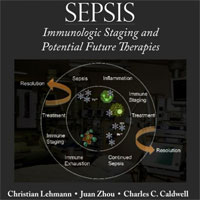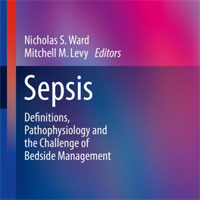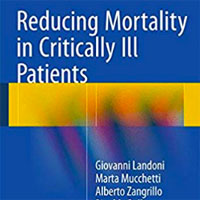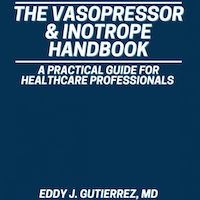Tag: infusion
Critical Care Opioids Impact in the 21st Century
Critical Care is impacted by opioids in multiple ways. Not only do they form the backbone of managing pain and sedation in the intensive care unit (ICU), the burgeoning opioid epidemic also feeds into opioid-related ICU admissions.... read more
Modified Version of the ACC’s low-dose 4PCC Warfarin Reversal Option Achieves Similar Outcomes for Lowering INR
A modified version of the American College of Cardiology (ACC) low-dose four factor prothrombin complex concentrate (4PCC) option for warfarin reversal achieves similar outcomes for lowering International Normalized Ratio... read more
Fentanyl Infusion Pharmacokinetics Variables in Obese and Nonobese Children
The differences in total clearance (CLS) may increase less than proportional to weight in obese children greater than 6-year-olds, while volume of distribution at steady state increases more than proportional to weight in... read more
Optimizing Therapy of Bloodstream Infection Due to Extended-spectrum β-lactamase-producing Enterobacteriaceae
Carbapenems should be used in patients with serious infections; alternatives could be used individually, particularly for definitive treatment of patients with milder presentations. Meropenem and imipenem are the drugs... read more
Transfusions Stuck in an Endless Cycle of Denial
Each publication from Maitland, et al., gives us a glimpse of a greater medical truth, but our view is obstructed by questions about external validity. This group published the landmark FEAST trial that questioned the... read more
Effect of Vitamin C Infusion on Organ Failure in Patients With Sepsis and ARDS
In this preliminary study of patients with sepsis and Acute Respiratory Distress Syndrome (ARDS), a 96-hour infusion of vitamin C compared with placebo did not significantly improve organ dysfunction scores or alter markers... read more
Clinical Examination for the Prediction of Mortality in the Critically Ill
Clinical examination has reasonable discriminative value for assessing 90-day mortality in acutely admitted ICU patients. In our study population, a single, protocolized clinical examination had similar prognostic abilities... read more
Extubating Ventilated Patients on Vasoactive Infusions is Safe
In a large single centre study, 21% of intubated patients who received infusions of vasoactive infusions while mechanically ventilated were extubated for the first time while still receiving them. Coincident with their earlier... read more
Subanesthetic Ketamine Infusions for the Management of Pediatric Pain in Non‐critical Care Settings
Ketamine can effectively be used as part of a multimodal analgesic regimen in pediatric patients in non‐critical care settings. Our five‐year experience using low‐dose ketamine infusions highlights an acceptable side... read more
Intravenous Lidocaine Does Not Improve Neurologic Outcomes after Cardiac Surgery
Intravenous lidocaine administered during and after cardiac surgery did not reduce postoperative cognitive decline at 6 weeks. Among the 420 allocated subjects who returned for 6-week follow-up, there was no difference in... read more
Midazolam Dose Optimization in Critically Ill Pediatric Patients with ARF
This work leveraged available knowledge on non-heritable and heritable factors affecting midazolam pharmacokinetic in pediatric subjects with primary respiratory failure requiring mechanical ventilation, providing the basis... read more
Sedation in the ICU – Good Past – Better Future?
The concepts for good sedation include defining the range of sedation, the need for agents with rapid response that can be easily and rapidly varied in restless and confused patients, various modes of ventilation, continuous... read more
Fluid Responsiveness in Sepsis
Fluid challenge is a common practice in the ICU. It is one of the most important resuscitation manoeuvres of acute circulatory failure management in critically ill patients. Adequate fluid resuscitation is very important... read more
Neuromuscular Blockade for ARDS Was No Help, In Supine Patients
Continuous neuromuscular blockade for severe ARDS became common practice after the ACURASYS trial showed it reduced mortality by an absolute 9%. A larger trial, ROSE, now finds no benefit of the therapy over usual care, but... read more
The Effect of Dexmedetomidine on Outcomes of Cardiac Surgery in Elderly Patients
The goal of this retrospective study was to investigate the effects of perioperative use of dexmedetomidine (Dex) on outcomes for older patients undergoing cardiac surgery. A total of 505 patients (equal or greater than 65... read more
Catheter Type in Pulmonary Embolism Intervention
Catheter based interventions for pulmonary embolism is on the rise. The rise in mainly in patients who present with submassive PE. The intent of intervention is to reduce clot burden. This is done to improve acute symptoms... read more
Catheter-Directed Therapy for PE Built on Fallacy
Tissue plasminogen activator has a notoriously checkered past within emergency medicine, and its controversial use continues with the advent of targeted therapy for pulmonary embolism. Catheter-directed administration of... read more
Dosing Adjuvant Vitamin C in Critically Ill Patients Undergoing CRRT
We read with great interest the recent letter to Critical Care by Marik and Hooper. Vitamin C is increasingly recognized as a crucial compound to alleviate morbidity in critically ill patients. Vitamin C concentrations, however,... read more
Vitamin C: Should We Supplement?
A short course of intravenous vitamin C in pharmacological dose seems a promising, well tolerated, and cheap adjuvant therapy to modulate the overwhelming oxidative stress in severe sepsis, trauma, and reperfusion after ischemia.... read more
Effect of Levocarnitine vs Placebo as an Adjunctive Treatment for Septic Shock
In this dose-finding, phase 2 adaptive randomized trial, patients with septic shock and moderate organ dysfunction were treated early in the course of illness with low (6 g), medium (12 g), or high (18 g) doses of levocarnitine... read more
A Multicentre Randomised Controlled Trial of Levetiracetam vs. Phenytoin for Convulsive Status Epilepticus in Children
Convulsive status epilepticus (CSE) is the most common life-threatening childhood neurological emergency. Despite this, there is a lack of high quality evidence supporting medication use after first line benzodiazepines,... read more
Ketamine Continuous Infusion: A Reasonable Alternative to Traditional Sedatives and Analgesics?
Propofol, dexmedetomidine, and opioids are commonly used for patients requiring continuous sedation or analgesia, such as for those receiving mechanical ventilation. Although these medications are generally safe, some may... read more









